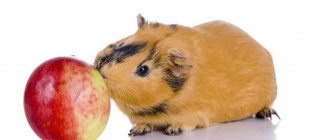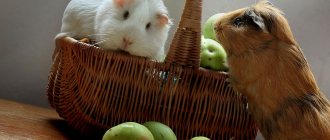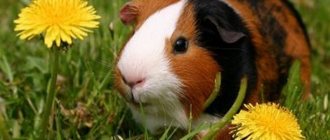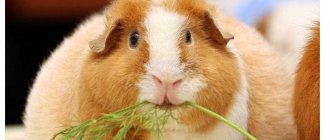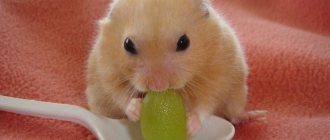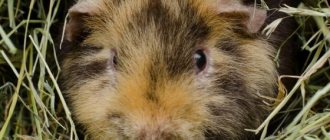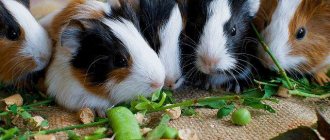Many people like to add a little variety to their guinea pig's diet by varying the fruits and vegetables they offer their pet in addition to the hay and dry guinea pig food or kibble that makes up the majority of their diet. Two foods that people may consider feeding their guinea pigs are grapes and raisins. So, are grapes and raisins safe for guinea pigs and do they add any nutritional value to their diet?
Decorative rats - grapes and raisins in the diet
Eating sweet fruits is a real pleasure for a rodent. However, this does not mean that such meals will be beneficial for her. Grapes are one of the sweetest and most high-calorie berries, therefore, both fresh and dried, they should be given with extreme caution. Excessive amounts may harm the health of the rodent. Provoke diseases of the gastrointestinal tract.
A domestic rat will happily accept grapes as a treat. Veterinarians advise giving any berries and fruits, no more than once or twice a week. And no more than 2 berries at a time. The same applies to raisins.
Grapes contain a large amount of B vitamins, many useful macro- and microelements: calcium, magnesium, potassium, iron, etc. So such a treat in reasonable quantities will definitely benefit your pet.
Fruits and berries should not replace the main meal. They are given as a nice sweet bonus. Also, grapes and raisins should not be fed to rodents on an empty stomach; this can lead to problems with the digestive system.
About the nuances of feeding
Based on this, one of these products (banana, grapes, apple, cabbage) can be given to the guinea pig 2 times a day (morning, evening). Even if you need to follow a diet, fruits are included in the diet in small doses.
In addition, it is extremely important that each time the fruits are fresh, washed. Leftover food should be removed after a couple of hours.
Feeding features include the need to consume one specific fruit per day. To avoid digestive problems, these and other fruits and vegetables are included in the menu gradually, without excessive fanaticism.
The diet should include fresh fruits and vegetables
Depending on the age of the guinea pigs, banana, apple, cabbage, grape food (but not as a treat) can and should be given at intervals:
- for cubs and pregnant pets – 4 times a day;
- adults – 2 times a day.
Quality grapes - what are they?
Many owners are very mistaken in believing that a decorative rat should and can eat absolutely everything. Including products that are far from fresh. When choosing grapes, you need to focus on fresh bunches. Rotten berries will bring neither benefit nor pleasure to a rodent. When choosing grapes, pay attention to their appearance.
Related article: Can guinea pigs be given peas and corn?
The best solution is to provide grapes grown in environmentally friendly conditions and without chemical treatment. Such berries can be collected at your summer cottage or bought from a small farmer at the market.
If wasps are constantly flying around a stand with grapes, this is an indication that it has not been treated with harmful chemicals. You can safely buy such berries. If you purchased them in a store, then before giving them to your pet, pour boiling water over them several times.
Grain feed
A guinea pig needs to eat at least 20% grain per day. Grain food for rodents is sold in any pet store. The finished product usually includes:
- barley;
- oats;
- millet;
- sunflower seeds;
- corn grains.
In addition to grain, prepared feeds may include vegetable granules and vitamin supplements.
Dry pet food is easy to prepare yourself; you just need to buy different types of grains on the market and then mix them. But you need to take into account that the main ingredient is oats; guinea pigs eat it more readily than other grains. Solid grain food should always be present in the diet of rodents. Animals need it to grind down their continuously growing teeth. If a rodent eats only raw and soft food, then its incisors become unnaturally elongated and interfere with the ability to absorb food. As a result, the animal dies from starvation.
Grapes with seeds or not?
Owners are often interested in the question: can a decorative rat be given sultanas? In fact, there is not much difference which grape is better. The presence of seeds will not harm your pet in any way. Typically, the list of prohibited foods for rodents includes pits of apricot, peach, plum, dogwood, cherry and sweet cherry. They contain a substance that is converted into hydrocyanic acid in the body.
But if we compare grape varieties with and without seeds, then, perhaps, the first option will be even more useful, since it usually contains less sucrose than the same sultanas.
To ensure that your rodent is always in a good mood and healthy, take care of its balanced diet. Sweets are something that rats will always eat with great pleasure, regardless of the nutritional value of the food. First of all, rodents focus on taste sensations.
Now you know that you can give grapes to rats, but it is very important not to feed the rodents sugary treats. After all, there should be a little bit of good.
cucumbers
Whether or not to feed a guinea pig cucumbers is a fairly common question that concerns many breeders.
Cucumber contains quite a bit of dry matter (sugar/protein/fiber/vitamins) - only 3-6%, the rest consists of water, so this vegetable is considered to be of little nutritional value.
But it is he who is involved in such an important process as the digestion and absorption of other necessary enzymes by the animal’s body
Give cucumbers to guinea pigs little by little and gradually, because... they can cause stomach upset, and there is also a risk of poisoning if the cucumbers are purchased.
What kind of vegetable is this?
A ripe cucumber is an excellent source of natural water, but it also contains vitamin C and potassium. Pigs like their taste and eat it with pleasure. In addition to quenching thirst, it promotes the absorption of nutrients. Cucumber is their natural food in the wild, so it can be added naturally to their diet.
An interesting fact is that cucumbers are not only tasty and healthy, but also beautiful; many cosmetics and even medicines are made from them.
Composition and beneficial properties
Cucumber consists of:
- sugar - up to 3%;
- fiber - 0.7%;
- vitamins C/A/B1/B2;
- water - more than 90%.
Thanks to this composition, it is considered a dietary vegetable, and it also helps to increase appetite. The pulp of this fruit contains silicon; it is this component that helps strengthen teeth and claws.
Fresh vegetables help increase the production of gastric juice, so you should carefully give it to pets who have problems with the gastrointestinal tract. Overeating can cause loose stools.
An important point is that cucumbers are considered a hypoallergenic product and, in principle, cannot cause intolerance, so they can be fed to pigs after they reach two months of age without worrying about the possible development of an allergic reaction.
In general, we can say with confidence that you can give cucumbers, but in small quantities, avoiding overfeeding.
How much can you give your guinea pig and how?
As mentioned above, you should not overuse cucumber, as overeating can cause indigestion. Cucumber, like other vegetables, is given to guinea pigs exclusively fresh, after washing. Cucumbers are given in chopped form, but not very chopped; there is no need to peel the peel.
Salted/pickled/canned cucumbers are prohibited for consumption by rodents and are considered unhealthy food. This is due to the sugar/vinegar and salt content in the marinade.
A fresh vegetable will not only diversify the animal’s diet, but will make it useful and healthy.
What foods can you feed guinea pigs?
Even experienced livestock breeders ask questions: what to feed their pet, whether it is possible to give certain products. Before getting a guinea pig, you should find out which foods will benefit the animal and which may harm its health. A guinea pig's daily menu should include vegetables, fruits, berries and cereals. Many vegetables and fruits can even be offered to your pet along with the peel. It is important to remember that not all foods that guinea pigs eat are equally beneficial for them. What rodents can eat and what they cannot feed a guinea pig is discussed in this article.
Article on the topic: Is it possible to give radishes (fruit, leaves, tops) to guinea pigs?
Is it possible to give hamsters persimmons?
There is an opinion that you need to let the hamster try the product. If he eats it, then you can feed him. This approach is fundamentally wrong. Most hamsters will eat any food they can get their hands on.
In nature, they can even consume poisonous foods to their detriment. Therefore, before feeding your pet this or that fruit or vegetable, you should first find out whether this can be done and consult with an experienced specialist.
Persimmon should not be given to Djungarian hamsters Despite all the beneficial properties of persimmon, giving it to hamsters is strictly not recommended for several reasons:
- Persimmons contain a large amount of sugar, which is one of the main prohibitions in the diet of domestic hamsters. This is especially true for Dzungarian and Syrian species.
- Your hamster's diet should include foods that they eat in their natural habitat. Persimmon is not one of these fruits, as it grows in other regions.
- Persimmons contain quite a large amount of tannins. They directly affect the functioning of the digestive organs. If you look deeper, tannins are used to regulate and slow down intestinal motility.
Vegetables
Can guinea pigs have radishes?
It is permissible to use only radish tops. The root vegetable contains essential oils that can cause irritation to the mucous membranes and respiratory tract of the animal. The vegetable also causes bloating. Therefore, it is not recommended to give radishes to pigs.
Can guinea pigs eat celery?
Celery can be given in any form - stems, leaves, roots. This vegetable is included in many dry food for rodents. Celery is enriched with vitamins B, PP, E, C, A and contains phosphorus, zinc, potassium, calcium, iron and magnesium. Before eating, celery must be washed thoroughly, especially the root.
Can guinea pigs eat tomatoes?
Ripe fruits can be included in the food. Tomatoes are well absorbed by animals and contain vitamin C and carotene, which are beneficial for their body. Green tomatoes contain solanine, which can negatively affect your pet’s health.
Too many tomatoes in an animal's menu can cause loose stools.
Can guinea pigs eat cabbage?
Cabbage can be included in the animal's diet. Cabbage contains many vitamins and other substances necessary for pigs:
- ascorbic acid;
- B vitamins;
- vitamins of the PP group;
- folic acid;
- sulfur;
- calcium;
- potassium;
- phosphorus;
- amino acids;
- microelements.
The vegetable is able to keep the animal’s fur in excellent condition and strengthen its immunity. The top dried leaves should be given. It is preferable to feed guinea pigs Chinese cabbage and broccoli. White cabbage can cause bloating.
Can guinea pigs eat potatoes?
Green and sprouted potatoes are contraindicated for guinea pigs. Raw vegetables can be given occasionally, cut into small pieces. Boiled potatoes can be offered to your pet separately or added to grains and other foods.
The vegetable contains solanine, which can harm the health of the animal if the pet eats too many potatoes. The pig will become passive and catch cold quickly.
Article on the topic: Can guinea pigs eat avocado, pineapple, mango and kiwi?
Can guinea pigs eat beets?
Beetroot contains many substances useful for animals: vitamins C, A and B, potassium, magnesium, phosphorus, iron. In excess, the vegetable contains fiber, so it acts on the animal’s body as a laxative. Store-bought root vegetables may contain nitrates, which are very harmful to the small body of guinea pigs. It is better to offer your pet homemade crops. The composition also contains a large amount of oxalic acid, so it is better to limit the consumption of this product.
It is recommended to give beets starting from 2 months; they are especially useful in winter and spring, when there are no fresh vegetables. The daily dose should not exceed 200 g, and it is better to exclude beets from the diet of pregnant and lactating pigs so as not to provoke an upset stomach. Beets turn stool and urine red, so if your animal has eaten them, don’t be alarmed by such changes.
Can guinea pigs eat pumpkin?
Pigs can be given all varieties of pumpkin that humans eat. For the digestion of herbivorous animals, such a product will be familiar and useful. Pumpkin contains vitamin C, calcium and phosphorus necessary for rodents. It should be borne in mind that this low-calorie vegetable will not be able to saturate the pig completely, so it is better to give pumpkin to guinea pigs as a treat.
Can guinea pigs eat bell pepper?
Another storehouse of ascorbic acid is bell pepper. Before use, the vegetable must be thoroughly washed and chopped, and the seeds removed. It is better to give the product together with dry food.
Green peppers containing solanine should not be given to animals, as should peppers in the form of hot seasonings. Spicy foods will damage the mucous membranes.
Can guinea pigs eat cucumber?
Cucumbers don't have as many nutrients as other vegetables. You can offer your pet a cucumber. The vegetable can harm your pet's health by causing digestive problems only if consumed in large quantities.
Article on the topic: Is it possible to give sorrel to guinea pigs?
Can guinea pigs eat zucchini?
Zucchini is suitable for the diet of guinea pigs. They contain small amounts of vitamin C, calcium and phosphorus. It is better to prefer young vegetables; they can be given along with the peel, cut into crowbars.
Vitamin C
The fact is that the body of guinea pigs does not contain a special enzyme, I-gluconolactone oxidase, which is involved in the synthesis of vitamin C from glucose. It is because of this circumstance that your pet is not able to get this incredibly valuable vitamin from regular food. Your task throughout the animal’s life is to regularly provide it with ascorbic acid.
With a lack of vitamin C in the body of an adult, the following pathologies can occur (most often manifested as symptoms of scurvy):
- retardation of movements, visual lameness (although the animal did not fall), decreased activity;
- lack of appetite, external lethargy and indifference to what is happening;
- diarrhea, swelling of joints;
- there is blood under the skin and in the secretions;
- bleeding and falling out teeth;
- the animal looks disheveled, the fur is crumpled, and may even fall out.
In summer, the diet should be replenished with plenty of fresh greens, plants, leaves and stems, not to mention fresh vegetables and fruits. Most of these fruits contain ascorbic acid. As for the cold winter period, it is necessary to gradually add synthetic ascorbic acid to the diet. Pregnant females, older individuals and young animals need an increased dose of vitamins, as well as an increased amount of food.
For an adult, you need at least 15 mg of vitamin C per kilogram of weight daily; for pregnant women and young animals, approximately 40-45 mg per kilogram of weight should also be given every day.
The greatest amount of vitamin C is found in the following vegetables, plants and fruits: tomatoes, broccoli, apples, nettles, burdock, as well as raspberry and currant branches (always with leaves), dandelion, basil, mint, parsley, cabbage, kiwi. Remember that many of these plants should be given in strictly limited quantities.
Almost all of the listed vegetables and fruits can be found in the public domain in the summer and autumn, which is why preference should be given to these products in the summer rather than synthetic vitamins.
Be careful when choosing a place to collect all the necessary herbs (in case you do not trust herbs from pet stores). Try to choose areas far from factories, roads and industrial enterprises to collect them. The greatest danger is in grass collected from parks and city lawns. Typically, such plants are treated with harmful chemicals against parasites, which will also negatively affect your pet.
There are only two problems with such capsules:
- you will not recognize their composition in any way due to the fact that the mixture is homogeneous; it is impossible to determine the composition, as well as to detect the presence of sawdust and dust, which sellers love to add to capsules;
- capsules are intended for long-term use, they can be stored for a long time in one specific place, and ascorbic acid, after 3 months from the date of production, begins to gradually deteriorate and loses its beneficial properties.
When purchasing ready-made feed mixtures, you should always check the production date. To ensure that the food is fresh and does not spoil, it should be stored in a dry, dark place with low humidity. It is under such conditions that ascorbic acid will slow down the decomposition processes.
So, what to feed your guinea pig? Greens that contain large amounts of ascorbic acid. In the wild, these rodents eat a lot of grass. At home, such animals may lack vitamin C. Therefore, you need to additionally purchase special medications. Before giving any products to your animal, be sure to consult your doctor.
What other foods contain much-needed vitamin C? What to feed your guinea pig? You can give the animal salad, rose hips, sweet peppers, fresh herbs and sprouted grains. Another option is to mix vitamins with drinking water (5 mg added to the drinking bottle). In addition, there is also injectable ascorbic acid, which is sold in regular pharmacies. The dosage should be recommended by a veterinarian.
We suggest you familiarize yourself with: How to correctly give a subcutaneous injection to a cat in the withers and intramuscularly in the thigh: technique, photos, videos. What syringe should I use to inject a cat?
Fruits and berries
Bananas
Can guinea pigs have bananas? A banana rich in potassium will benefit your guinea pig, but you should not give more than 1 piece per day.
The peel of the vegetable must be removed, as it is treated with substances hazardous to health (wax, chemicals, ethylene and pesticides). For safety, it is better to remove soft fibers from the fruit.
Can guinea pigs eat a pear?
Pears can be given with the peel, but without the seeds. The fruit is washed well and cut into pieces; the pig should be offered water along with it. Excessive consumption of pears due to their high sugar content can cause diarrhea.
Can guinea pigs eat kiwi?
Kiwi is a very healthy fruit for animals. It contains a large amount of ascorbic and folic acids. It is also rich in vitamins E, iron, calcium, magnesium and phosphorus.
Kiwi is given without skin in the form of small pieces. For your pet, you need to choose harder fruits. It is better to control the amount you eat. An increase in the dose of kiwi is permissible in autumn and winter, as well as when feeding females during pregnancy and lactation.
Can guinea pigs have oranges and other citrus fruits?
Can be used occasionally. But it is better for guinea pigs to get vitamin C from other foods, avoiding citrus fruits. Possible complications:
- oversaturation with vitamins;
- skin irritation;
- oxidation of urine.
Can guinea pigs eat apples?
Apples can be raw or dried. They have a balanced ratio of sugar and fructose (18:80%). It allows the pig to be active.
The fruit must be peeled and cut into slices. It is better not to give more than 3 pieces at a time.
Article on the topic: Can guinea pigs eat apricots, peaches and nectarines?
Can guinea pigs eat strawberries, grapes and other berries?
Strawberries contain a sufficient amount of vitamin C to pay attention to the berry when choosing a treat for a rodent. You can also give strawberry leaves to animals.
- The pig might like grapes. You can offer the animal seedless grapes.
- Eating currants once a week will also not harm your pet.
- If you do not abuse it, you can offer the pig berries and raspberry leaves, berries, leaves and branches of blueberries, blackberries and sea buckthorn, and rose hips without seeds.
- Cranberries are given for medicinal purposes. It has an anti-inflammatory effect on the mucous membranes of the mouth, stomach, and bladder.
Rules for natural nutrition
Regarding feeding the Pomeranian Spitz with natural food, there are general recommendations:
- Provide your dog with access to clean drinking water. Change it daily.
- Do not mix natural food and dry food. Choose one diet or give food at different times.
- If you decide to change your diet, you can’t do it right away. The shift period should take 2-3 weeks.
- Give only fresh food. If your pet doesn't eat enough food within 15 minutes, don't let him eat until the next meal.
- Determine the amount of food based on your pet's weight.
- The diet should be balanced. If you decide to feed your dog, consult your veterinarian for recommendations.
Dogs should not be given sweets.
Spitz can be given meat raw or slightly scalded, but only after preliminary freezing. Replace meat with offal two to three times a week.
Offal products that are an excellent addition to a natural diet include:
- scar;
- liver;
- lungs;
- kidneys;
- trachea.
By-products You can also give dogs low-fat sea fish, but not earlier than four months of age. This product should be given deboned, no more than once a week, completely replacing meat with fish.
Sour dairy products must be present in the diet. Their norm is no more than 30% of the daily food intake. For up to six months, your Spitz should be given cottage cheese every day. It is rich in calcium, which allows the formation of a healthy bone skeleton and cartilage tissue.
Add fermented milk to your diet about five times throughout the week.
The carbohydrate component is porridge, but not more than 15% of the total daily diet. You can feed buckwheat, rice, and oatmeal cooked in water or low-fat broth (no more than 2-3 times a week).
Suitable cereals for feeding
Egg yolks are responsible for the fat component. You can give quail eggs, but no more than 1-2 times a week in the amount of two or three pieces.
In hot weather, feed your dog once a day. During cold weather, distribute food evenly.
Pregnant and lactating bitches should not be hungry, so the food bowl does not need to be removed immediately after eating.
Dairy
Can guinea pigs have milk?
Giving milk to guinea pigs is not recommended. The enzyme that is responsible for the breakdown of milk sugar (lactose) is found in insufficient quantities in the body of animals. If your pig drinks milk, the lactose will cause diarrhea and bloating. More serious diseases may develop in the future, so it is better to show your pet to a doctor.
Females can and even need to be given milk during lactation. You can soak crackers in milk and offer them to your pig.
The ban also applies to other dairy products: cottage cheese, cheese, yogurt and others.
Other products
Can guinea pigs eat bread? It's better not to give.
- Fresh yeast bread takes a long time to digest and causes fermentation in the animal’s stomach.
- White bread causes bloating.
- Your pet can eat stale bread, but not often.
- Dried bread with seeds, sesame seeds and raisins can sometimes be offered to your pet as a treat.
Can guinea pigs eat nuts and seeds?
Nuts and seeds are among the allowed foods, but can cause obesity if their consumption is not limited. It is better to offer your pet almonds, walnuts or hazelnuts.
The seeds contain many components useful for the animal: fatty acids, calcium, sodium, phosphorus, proteins and vitamins. It is better to give peeled seeds and make sure that they are no more than 15% of the total feed.
Article on the topic: Can guinea pigs eat black or white bread?
What is harmful for pigs?
Some foods are given to animals in limited quantities. They may not lead to serious poisoning, but they will definitely upset the rodent’s digestive system.
Vegetables
A list of vegetables that are not suitable for a pig’s daily diet or should be excluded completely:
- Tomatoes. Despite their nutritional value, the high content of acids (including citric, oxalic, abscisic), when fed daily, will lead to irritation of the rodent’s delicate stomach. Therefore, a small piece of tomato can be given no more than once a week.
- White cabbage, cauliflower, Brussels sprouts, red cabbage. It has a rich set of microelements, but the animal's digestive system is not designed to digest large quantities of cabbage leaves, which can cause severe diarrhea.
- Legumes are given only in the form of young sprouted stems. Boiled or raw peas and beans will cause bloating and poisoning. Let's say there is a small amount of fresh green peas.
- Potato. Eating large amounts of starch is harmful for the animal. Potato tops are the strongest poison.
- Radish, radish. Contain harsh essential oils that can severely harm the digestive system. Therefore, they do not need to be included in the diet.
- Animals should absolutely not eat garlic and onions to avoid burns to the esophagus.
- Bell peppers are given in limited quantities. It may upset digestion. It is absolutely forbidden to give hot pepper.
Article on the topic: Can guinea pigs eat raw and boiled beets, and in what quantity?
Fruits, berries
List of unwanted and prohibited fruits and berries:
- Sour apples are contraindicated for pigs.
- Lemon is strictly contraindicated for animals; it is a strong acid.
- Oranges and tangerines, peeled and peeled, should be well-ripened and sweet. Citrus peels are poisonous to rodents. In addition, the pig may have individual intolerance.
- Choose hard pears to avoid diarrhea.
- Banana is harmful because it can cause obesity.
- Melons (watermelon, melon) contain a lot of harmful sugars and weaken the stomach. Their use is limited.
- Stone fruits (plum, peach, apricot, cherry) are too sweet and disturb digestion.
Dried fruits are not on the list of prohibited foods. However, they must be prepared without the use of preservatives. You should not get carried away with them so that the animal does not get diabetes.
Animal products
Unlike hamsters, guinea pigs do not need food of animal origin. Their digestive system is capable of digesting only plant foods. You cannot offer them milk, cottage cheese, butter, meat, eggs, or fish. In their natural habitat they do not eat such food.
Herbs
The choice of grass and hay must be approached carefully. It is enough for an animal to eat a small amount of a poisonous plant to become poisoned.
Poisonous herbs include: celandine, datura, spurge, lily of the valley, poppy, hemlock, mustard, marsh marigold, foxglove, wild rosemary, night blindness, hellebore, buttercups, borer, larkspur. St. John's wort, milk thistle, coltsfoot, dandelion, and wormwood should be limited.
The animal should not eat herbs, for example, mint, thyme, sage, basil.
When there are doubts about edibility, such greens are not offered to the rodent.
Indoor flowers
The vast majority of indoor flowers are poisonous. Common plants such as aloe, monstera, kalanchoe, cyclamen, ivy, dieffenbachia, philodendron, spathiphyllum, violet should not be within the animal’s reach.
If your pet has enough food, he will not try to try indoor plants. Situations are different, so flower pots should be lifted from the floor.
Article on the topic: Can guinea pigs eat raw potatoes?
What other foods are contraindicated for pigs?
What is not poisonous to humans can be destructive to the delicate body of a guinea pig.
Products that should be included in the diet in very small quantities:
- hazelnut;
- Walnut;
- seeds (sunflower, pumpkin, dill, sesame).
Sweets should never be given to a rodent. Candies, chocolate, marshmallows, halva are heavy foods that will lead to poisoning. Even the smallest amount of chocolate acts as a strong poison on the pig’s body.
You should not tempt fate and give the animal exotic fruits, no matter how much he begs for them. The pig is not given baked goods (including crackers, bagels), cookies, boiled porridge, soups and borscht in any form. The digestive system of these animals is not adapted to thermally processed foods.
Banana
Can guinea pigs have bananas? Bananas contain a lot of vitamins and microelements. But this exotic fruit can be given occasionally in limited quantities, since due to the high sugar content in this fruit, problems with the rodent’s digestion may occur.
As for banana peels, you should not give them at all. After all, bananas are treated several times with chemicals for long-term storage. And just because your pet eats banana peels doesn't mean you can feed them to your guinea pig.
Results
Guinea pigs are unpretentious in maintenance and care and are not picky about food. At first glance this seems like too many restrictions. In fact, the rule is simple: food should be healthy, low-fat, free of chemicals, spices, salt, and not irritate the esophagus. Grains, greens, most fruits and vegetables, branches of fruit trees - the list of permitted products is very large. In addition, you can always buy ready-made balanced grain mixtures in the store.
Sources:
https://animallittle.ru/mozhno-li-vinograd-krysam.html https://nalugah.ru/zhivotnovodstvo/morskie-svinki/chem-mozhno-i-nelzya-kormit-morskuyu-svinku.html https:// msvinkam.ru/pitanie/chto-nelzya-morskim-svinkam.html

